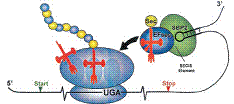Biochemistry, Department of

Vadim Gladyshev Publications
Document Type
Article
Date of this Version
July 2007
Abstract
Selenocysteine (Sec) and pyrrolysine (Pyl) are rare amino acids that are cotranslationally inserted into proteins and known as the 21st and 22nd amino acids in the genetic code. Sec and Pyl are encoded by UGA and UAG codons, respectively, which normally serve as stop signals. Herein, we report on unusually large selenoproteomes and pyrroproteomes in a symbiont metagenomic dataset of a marine gutless worm, Olavius algarvensis. We identified 99 selenoprotein genes that clustered into 30 families, including 17 new selenoprotein genes that belong to six families. In addition, several Pyl-containing proteins were identified in this dataset. Most selenoproteins and Pyl-containing proteins were present in a single deltaproteobacterium, δ1 symbiont, which contained the largest number of both selenoproteins and Pyl-containing proteins of any organism reported to date. Our data contrast with the previous observations that symbionts and hostassociated bacteria either lose Sec utilization or possess a limited number of selenoproteins, and suggest that the environment in the gutless worm promotes Sec and Pyl utilization. Anaerobic conditions and consistent selenium supply might be the factors that support the use of amino acids that extend the genetic code.


Comments
Published in Nucleic Acids Research, 2007, Vol. 35, No. 15.